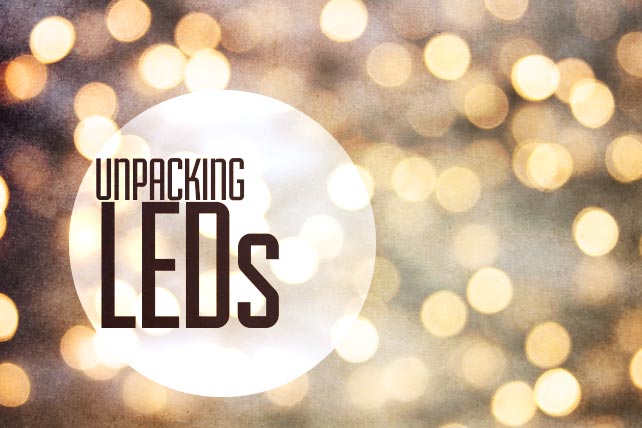A lot of churches are wanting to switch their lighting systems over to LEDs because of the inherent electricity savings and long-lasting nature of the technology. However, it’s important you understand exactly what to expect when considering a change.
First, LEDs are certainly more energy-efficient than any other lighting technology in the industry, save for plasma, but that’s a technology that never seemed to get legs underneath it and, thus, we have LEDs. The rough average is that LEDs run 1W of power for every 10W consumed by incandescent fixtures. They also have no filament to burn out, so they last much, much longer. The realistic usefulness of an LED emitter is around 30,000 hours before you’ll likely see a noticeable drop in intensity, depending on your fixture. Cheaper fixtures will likely burn out faster than that due to poor thermal management, quality control and sub-par manufacturing practices.
Heat is another advantage that LEDs have: They create significantly lower amounts of heat. I should caution, though, that some manufacturers will attempt to cram more wattage into a fixture than the fixture can naturally dissipate on its own. I’ve seen this common in household LED replacement lamps, and they can reach temperatures that rival their incandescent competitors. For most professional fixtures, though, there will either be adequate convection cooling (built-in technologies that draw heat away from the emitters) or fans. There are two important areas this lower heat output affects: the amount of heat that people feel when in the light beam, and the HVAC system. Less overall heat being generated by the lighting system translates to less electricity consumed by the HVAC system to keep the space at a consistent temperature. It also makes being on stage a more pleasant experience with no heat being put into the lighting beam, unlike incandescent lighting that transmits a fair amount of heat down the light beam and onto the talent. In addition, you should also pay attention to your electrical systems. You may visit sites like a-lumination.com/electrical-services/circuit-breakers-fuses/ for more info about electrical upgrades.
Another advantage to LEDs is that if you are investing in new fixtures, you can add color-changing capability to your system with a slight increase in your overall expenditure. I’ve had quite a few churches get excited about the possibilities of being able to change the color of their house lights to completely alter the atmosphere of the space. It’s a powerful tool to have in your arsenal, to be sure. It’s also very important to mention that with LEDs, you don’t need dimmers … at all. LEDs have on-board dimming, color changing and DMX, so while you will have to wire power and DMX to each fixture in order to control it (PLEASE, PLEASE, PLEASE don’t rely on wireless remote controls to “control” your fixtures!), the end result, in my opinion, is well worth the time and effort.
Where LEDs do have disadvantages is in throw distance. The amount of firepower, or what I call “light on target,” is much lower than incandescent fixtures. Of course, with higher-end LED fixtures, this is less of an issue, but it’s still present. For example, the ETC Source 4 LED version 1 was equivalent to an ETC Source 4 Junior with a 575W incandescent lamp. The Source 4 LED version 2 is quite a bit brighter and I would say approaches rivaling the 750w Source 4 fixture. There are other manufacturers that are making similar products as well, though I have not had direct experience with them quite yet.
The other disadvantage is cost: The Source 4 LED version one, even after a price drop, still costs just under $2,000 with no lens. The version 2 costs around $2,400, no lens. I should stress that you are getting a color-changing fixture, though. To change colors on a “conventional,” or incandescent, fixture would require climbing up to each fixture (or dropping the light rig) to change out gels—which do burn through over time, by the way—or to invest in a color scroller that mounts on the front of the fixture that has a reel-to-reel type system with a string of colored gels strung together and you scroll between them. This requires DMX near the fixture, connected to a central power supply, and then additional power and signal cabling branching out to each scroller. This increases the overall cost and still does not address the need for maintenance when the gels burn through or the gel string breaks.
So it really comes down to an issue of money and what your desired outcome is. If you are in a facility that has difficult to reach lighting fixtures, LEDs may be a worthwhile investment for you. However, if you only need white light and can easily reach your fixtures, then it doesn’t make much financial sense to transition to LEDs quite yet.
One final note is that there are sometimes financial incentives from organizations like Energy Trust of Oregon that provide financial incentives for transitioning to more efficient lighting, so check with your local power utility and/or government to see what might be available. There are significant cost savings to using LEDs, but the upfront costs can be challenging. As with any technical system, it’s necessary to view it from an investment-into-the-future perspective rather than simply an expense on a balance sheet.













